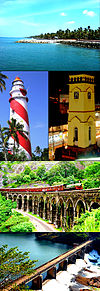Neendakara
Neendakara | |
|---|---|
Urban Village | |
 Neendakara Port, Kollam | |
| Coordinates: 8°56′19″N 76°32′25″E / 8.93861°N 76.54028°E | |
| Country | |
| State | Kerala |
| District | Kollam |
| Languages | |
| • Official | Malayalam, English |
| Time zone | UTC+5:30 (IST) |
| PIN | 691582 |
| Telephone code | 0476 |
| Vehicle registration | KL-23, KL- |
| Nearest city | Kollam City (9 km) |
| Climate | Tropical monsoon (Köppen) |
| Avg. summer temperature | 35 °C (95 °F) |
| Avg. winter temperature | 20 °C (68 °F) |
Neendakara is a suburb of Kollam city in Kerala, India.[1] The twin harbours, Neendakara and Shakthikulangara are located here. |url=https://www.tourmyindia.com/states/kerala/neendakara-port-kollam.html Trawling ban and withdrawal of the state official start from Neendakara harbour. It is about 10km away from the city center.[2]

Location[]
Neendakara is 30 km north of Paravur and 14 km south of Karunagappally town.
History[]
When Portuguese traders settled in Kollam (then Quilon) in the early 16th century, their ships passed through the Neenadakara bar, now the site of Neendakara Bridge, part of National Highway 66, which connects the village to Sakthikulangara across Ashtamudi Lake.
Etymology[]
In Malayalam, Neendakara means "a long bank".[3]
Norwegian Project[]
The headquarters of the Indo-Norwegian Fisheries Community project, established in 1953, was based in Neendakara until 1961, when the site was handed over to the Government of Kerala.[4]
See also[]
References[]
| Wikimedia Commons has media related to Neendakara. |
- ^ [1] Kollamnic.in|Villages in Karunagappally Taluk
- ^ "Kollam braces for monsoon trawl ban". Deccan Chronicle. 9 June 2016. Retrieved 7 November 2019.
- ^ Gulati, Leela (1984). Fisherwomen on the Kerala Coast: Demographic and Socio-economic Impact of a Fisheries Development Project. International Labour Organisation. pp. 48. ISBN 978-92-2-103626-5. Retrieved 20 May 2009.
- ^ "History". National Institute of Fisheries Post Harvest Technology and Training. Retrieved 20 May 2009.
- Villages in Kollam district


